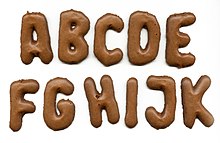Russian bread
Russian bread (or Russian bread ) even Patience is a dry biscuits from a foamy cocoa-protein dough without addition of fat. It is traditionally baked in the form of letters .
Manufacturing
For production , a dough (technically: a " mass ") is made from egg whites , sugar , cocoa and flour , depending on the recipe with other ingredients such as cornstarch , caramel syrup and cinnamon . This mass is then spread thinly on a baking sheet lined with oiled baking paper or shaped into letters with a piping bag ("dressing"), dried at a moderate temperature and then briefly baked. If necessary, the sheet of dough is cut into sticks while it is still hot.
Origin and history
Eating scriptures is an ancient magical custom. Edible characters were used as a didactic aid until the 19th century . In Encyclopaedia of German superstition of Bächtold-Stäubli several examples are given. According to an old Irish biography of St. Columban he learned to read while eating an alphabet cake.
There are various etiological narratives that are given by the producers of the product in a marketing- effective manner.
- Russian bread is believed to come from Saint Petersburg , where it was known as Bukwy ( Буквы , English: "letters"). The baker Ferdinand Friedrich Wilhelm Hanke (1816–1880) from Dresden got to know the recipe there and brought it with him around 1844. In Dresden in 1845 he opened a "German & Russian bakery", in which Germany's first Russian bread was baked with Latin letters. The industrial production of Russian bread has been a tradition in Dresden since the beginning of the 20th century. The first industrial manufacturer from 1898 was the "Baked goods company Gebr. Hörmann" and in their successor the "VEB Dauerbackwaren Dresden". After the transfer of the trademark rights, "Dresdner Russisch Brot" will be sold by Dr. Quendt GmbH & Co. KG . Its founder Hartmut Quendt had developed a system for the production of Russian bread for VEB Dauerbackwaren and took over production in 1991.
- In Vienna presented from 1858 Victor Schmidt & Sons (now men to those baked goods) ago. In this context, the legend is rumored that in the 19th century when Russian ambassadors were received at the Viennese court, "Russian bread" was offered, alluding to the Russian custom of greeting of bread. In Austria, this baked good is also known as patience and is one of the classics of industrial food production. Patiencen in the form of Latin characters are made with and without a chocolate coating and in Austria both versions are a popular seasonal product at Christmas time.
- Since 1904, the Hanoverian long-life baked goods specialist Bahlsen has been producing a type of Russian bread under the name "Leibniz-ABC". According to the company, Russian bread is derived from "Rösches Brod" (rösch = crispy; bread = sweet baked goods). The term "Russian bread" is based on a folk etymological reinterpretation.
- Since the capacity of the VEB Rubro in the 1970s in the GDR was no longer sufficient to cover the demand, Hartmut Quendt received the order to develop a permanent baking system in the 1980s. This went into operation in 1988, replacing manual baking (tapping the letters by hand).
font
Computer fonts in the form of Russian bread letters are offered by Linotype as the “Russian Bread” family and by Data Becker as “Russianbread”. The Data Becker font has only uppercase and small caps , the Linotype version has uppercase and lowercase letters.
See also
Individual evidence
- ↑ a b The Russian bread and its secret . www.dr-quendt.de. April 17, 2003. Archived from the original on December 21, 2006. Retrieved on February 6, 2011.
- ↑ Dresden companies and their leap into the market economy. (PDF, 8 MB) Saxon State Government, Scientific Society for Conveyor Technology and Packaging Dresden eV, accessed on March 22, 2014 (display boards for an exhibition).
- ↑ FAQs: Brand Bahlsen; Where does the name "Russian bread" come from? . bahlsen.com. Archived from the original on December 3, 2010. Info: The archive link was automatically inserted and not yet checked. Please check the original and archive link according to the instructions and then remove this notice. Retrieved September 4, 2010.
- ↑ Dr. Quendt GmbH & Co. KG: "Russian bread: Part 3 of 3: 30 years of Russian bread as a 'long-running hit'" . In: Dr. Quendt GmbH & Co. KG . 2018.
- ↑ Linotype Russian bread font family at MyFonts

